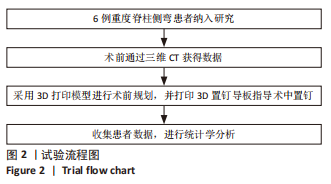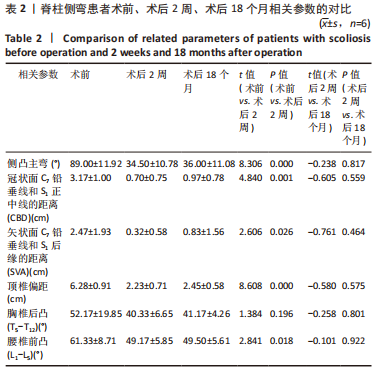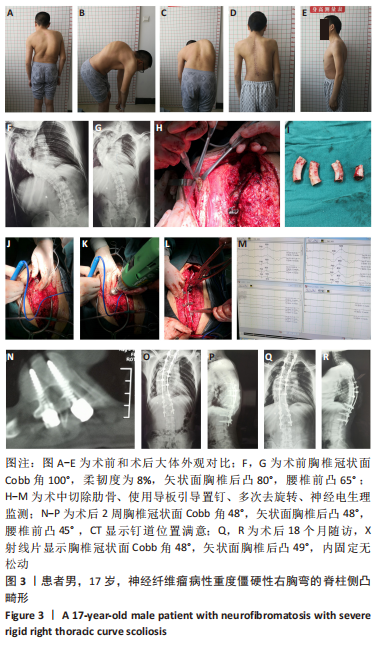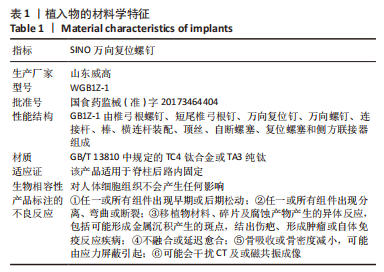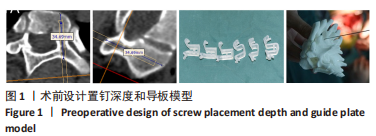中国组织工程研究 ›› 2024, Vol. 28 ›› Issue (6): 922-926.doi: 10.12307/2023.763
• 骨科植入物 orthopedic implant • 上一篇 下一篇
3D打印导板技术联合多次去旋转治疗重度僵硬性脊柱侧凸
张之栋,祁家龙,裴少保,马 力,王善松,刘艺明
- 合肥市第一人民医院脊柱外科,安徽省合肥市 230061
3D printed guide template technique combined with multiple derotation for severe rigid scoliosis
Zhang Zhidong, Qi Jialong, Pei Shaobao, Ma Li, Wang Shansong, Liu Yiming
- Department of Spinal Surgery, Hefei First People’s Hospital, Hefei 230061, Anhui Province, China
摘要:
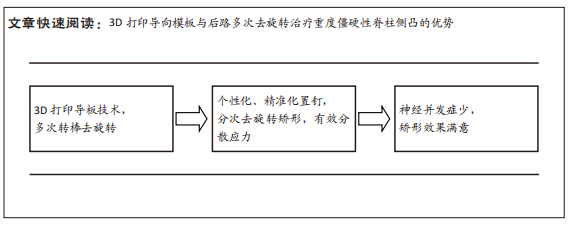
文题释义:
3D打印导板技术:利用术前CT扫描建模,术前规划设计需要置钉的关键椎及螺钉的直径、方向和深度,预制导向模板,术中根据导向模板置钉,很好地控制螺钉的方向和深度,具有置钉准确性高等优势。导板采用聚乳酸材质,可满足医用无菌消毒。3D打印导板在追求个性化、精准化的现代医疗中发挥重要作用。多次去旋转技术:针对重度脊柱侧弯,术后矫形难度较大,无法一次矫形到位。多次转棒去旋转可通过蠕变效应使得变形椎体周围的肌肉、韧带、椎间盘得到松解,对抗矫形的阻力减少,实现最大程度的矫形效果,不容易出现螺钉松动等并发症。
背景:近年来,随着3D打印技术的发展,使得外科手术走向个性化、精准化。3D打印导板技术可实现术前规划、术中导航,使得外科手术更加精准。临床中重度僵硬性脊柱侧弯矫形术中仍面临置钉准确性不高导致螺钉松动甚至引起神经并发症的问题,现有关于3D 打印导板技术指导重度僵硬性脊柱侧弯术中置钉的研究不多。
目的:评价3D打印导向模板技术联合后路多次去旋转治疗重度僵硬性脊柱侧凸的临床效果。方法:回顾性分析3D打印导向模板椎弓根螺钉置入后联合施行后路多次转棒去旋转技术治疗重度脊柱侧凸6例患者的临床资料,男3例,女3例,手术时年龄15-23岁,平均(18.17±3.49)岁。分析术后2周和术后18个月时脊柱侧弯相关参数的变化,进行统计学分析。
结果与结论:①手术时间280-540 min,平均(340.83±102.20) min,术中出血量1 000-4 000 mL,平均(2 000.00±1 073.70) mL,固定节段9-14个椎体,平均(11.83±1.72)个椎体,矫形过程中未出现螺钉松动;②所有患者均获得随访,术后2周全脊柱正侧位片显示冠状位主弯的cobb角、冠状面C7铅垂线和S1正中线的距离、矢状面C7铅垂线和S1后缘的距离、顶椎偏移、胸椎后凸角、腰椎前凸角均获得明显矫正,主弯的cobb角平均矫正率62.22%,术后18个月随访各参数较术后2周无明显变化,矫形效果满意,无感染和内固定断裂;③围术期切口延迟愈合1例,经过换药处理瘢痕愈合,未出现神经并发症;④结果表明3D打印导向模板结合后路多次转棒去旋转技术治疗重度僵硬性脊柱侧凸畸形安全有效,矫形效果满意。
https://orcid.org/0000-0001-9799-1522 (张之栋)
中国组织工程研究杂志出版内容重点:人工关节;骨植入物;脊柱;骨折;内固定;数字化骨科;组织工程
中图分类号:
